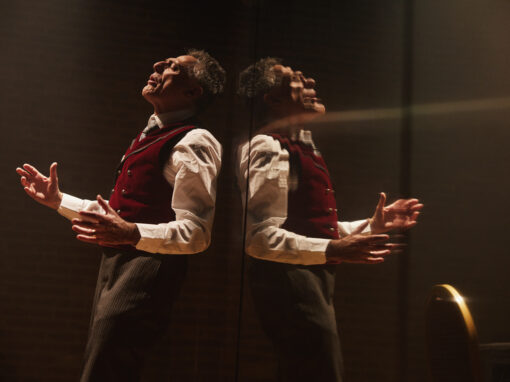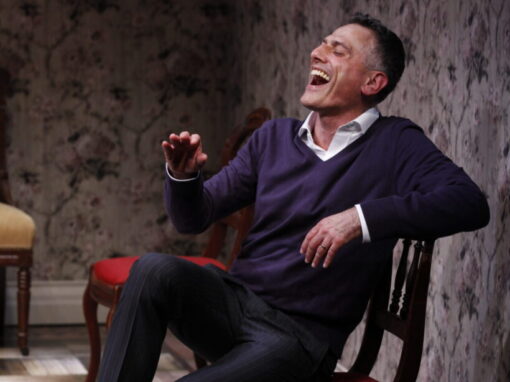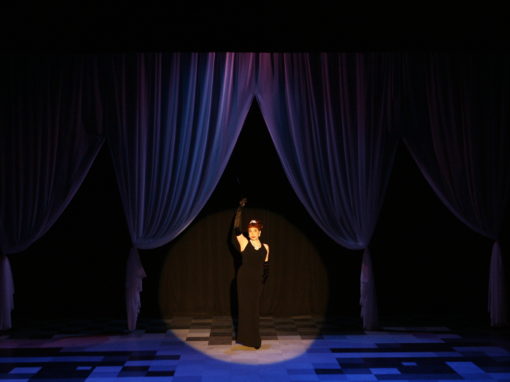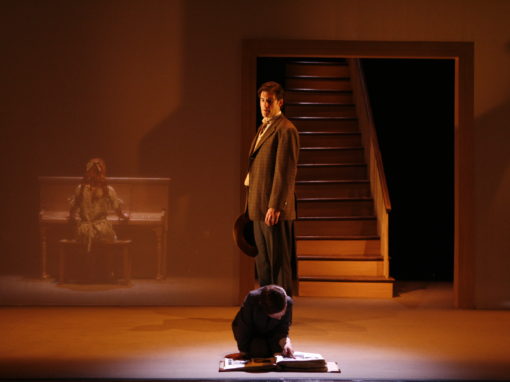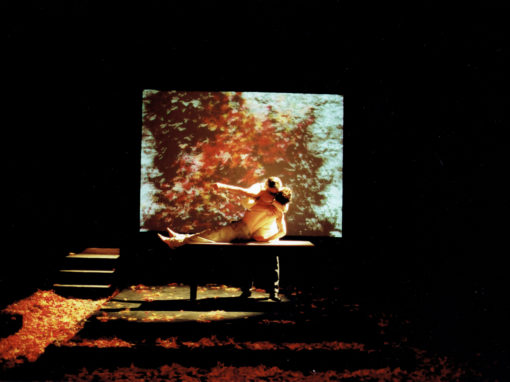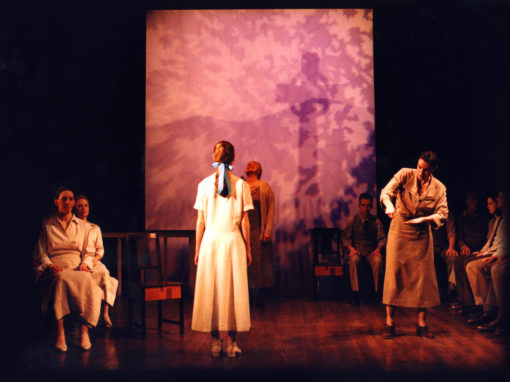We Have Been Here Before and Together We Will Come Through // by Lori Fineman
Musical theatre, a turn-of-the-century poet, and psychadelic drugs find common ground.
In the summer of 2018, I read The New York Times bestseller by food writer, Michael Pollan, How to Change Your Mind: What the New Science of Psychedelics Teaches Us About Consciousness, Dying, Addiction, Depression, and Transcendence. Uh, yeah. It was actually the cover art that drew me to this book (yes, it was the cover, I’m sorry), which was a picture of an out-of-reach solid black ceiling with a small square opening that allowed a tiny view of a blue and nearly cloudless sky. It looked like a place where I wanted to go.
The book is about expanding one’s consciousness through the mysterious chemicals, generally psilocybin, found in mushrooms (food writer!), and their effect on the brain, which aside from recreational, trippy fun (or terror), can be used in therapeutic ways to open the mind to seeing the world from a (usually much-needed) new perspective. The mushroom-trip induced world reported for most travelers is a place where one can clear the mind’s psychological cobwebs and glimpse the limitless of the universe. Cool.
While I was reading the book, I was also in intense pre-production with the Transport Group staff for our next show, the world-premiere musical Renascence, by Carmel Dean and Dick Scanlan, built around the poetry of Edna St. Vincent Millay, the Pulitzer Prize-winning, early 20th century American poet. The songs in the show were Millay’s poems set to Carmel’s original score. Dick wove the songs together into a narrative that roughly followed the course of Millay’s convention-breaking early life.
The crazy and amazing part is that the two subjects – Renascence and mushrooms – were about the same thing, and I realized I had received a serendipitous message from the universe that this was my time to do a deep dive into mushrooms or poetry. I picked poetry.
The title of the show, Renascence, is also the title of the poem that launched Millay’s poetry career; she achieved literary fame after the poem was published as part of a poetry contest in 1912. She blew away the critical literary community with her work – and then they found out she was a woman (which was annoyingly controversial and unexpected in 1912) and only 19 years old (yes!!). Renascence is a long and complicated poem and demonstrated not only Millay’s tremendous skill and talent with words, meter, and phrasing but also her sophistication as a visionary artist.
The overarching theme of the poem is about boundless connectedness, among humanity and all living things. The first-person narrator of the poem lives through a breathtaking, experiential realization of that connectedness, hearing the cries and feeling the pain of others from across the world. They experience their own death and resurrection and the dissolution of their body and soul, to where it’s possible to touch the divine. This was exactly the experience Pollan described in his book. It’s possible Millay experimented with mushrooms from her rural Maine, seaside upbringing; regardless, she was gifted with genius-level, prophetic literary powers.
It actually hurts to wrap your brain around Millay’s meaning for Renascence and the experience she describes. But that is the work of poets, isn’t it? To offer a mind-shifting perspective between people and their experiences? The work of poets can be extended to include all artists in pursuit of the perfect expression of their own perspectives. Lucky for us, the theatre artists who created Renascence for Transport Group achieved this as well, with a beautifully collaborative recipe of design, music, sound, words, movement, performance, and space.
Thanks to set designer Brett Banakis, Acts 1 & 2 of the show were performed on a thrust stage built over the first 8 rows of seating in the Abrons Arts Center Playhouse, bringing the actors closer to the audience. The stage curtain was the backdrop of this playing space. As an audience member we didn’t think twice about this arrangement – Transport Group is known for re-imagining the use of performance space. By the end of Act 2, we’ve watched Millay’s journey from the poetry contest in 1912, to her patron-sponsored time at Vassar, to her paparazzi-driven celebrity status and wild-child lifestyle, to her anguish at the separation from her family and loved ones. At the start of Act 3, however, the piece takes a dramatic shift; it is time to hear the musicalized version of the poem that started it all, Renascence. The action of the play stops. The stage curtain rises to reveal the actual stage behind the curtain. The stage was a gleaming, brightly lit space, with a grass floor, chairs for seating and sky-blue billowing fabric covering the walls and ceiling – it looked like a park! On stage! It was the place in the window on Michael Pollan’s book cover! Then the actors invited the audience up onto the stage and into our new seats. The entire audience moved, not just a few willing volunteers. In that moment, the play morphed into physicalized poetry; it felt like an invitation into some kind of existential crossover.
Seated up there on the stage, in the round, now visible to the entire audience and face-to-face with the actors, I realized that we had moved into Millay’s dominion. This was the place where perspective shifted, where the poet’s and the theatre artists’ hands turned your head and your heart in an unexpected and revelatory direction. Although we didn’t dissolve into the ether, the Playhouse beyond the stage where we had been previously sitting was now the abyss, plunged into darkness. Was it still there? We saw only each other – audience members and actors. It was impossible not to be fully present in the moment. If only the rest of New York knew what was happening in here! The actors sang the entirety of Renascence, set to soaring music, performed an arms-reach away from us. I was in a sanctuary, a sacred space of transcendent joy and love of life, and of rejuvenation like the journey described in Millay’s poem. Ah, to be in that seat again! I cherished my time in that space. Each time I was there, I stepped outside of my self-centeredness, crossed over into Millay’s world of rebirth and renewal, and lost myself in the words and the music.
Opening night for Renascence was October 25, 2018. That morning I woke up to the sounds of helicopters above my apartment building. Checking the news, there was a bomb threat on my corner, in front of the police precinct on my street. It was just another day in a particularly rough month for American current events, which included tone-deaf hearings of a Supreme Court nominee that rendered women’s voices irrelevant; too much hate-driven, senseless violence with guns against Black people, Jews, Muslims, Christians and children; border cages; the previously-mentioned New York City bomb threats; and other vomit-inducing events. We were also days away from an election that we hoped would repair some of the damage from 2016.
Ooof.
I shared pre-show remarks with the company about how proud I was of what they had created and how powerfully I personally experienced the magic we made in that theatre. I also shared with the company another poem of Millay’s that was uncannily relevant that night. The poem was a Thanksgiving poem commissioned by The Saturday Evening Post, written in October 1950, just days before Millay’s death. At that time in her life she was an outspoken pacifist and supporter of veterans. Although written for actual soldiers, I think we can substitute ourselves as soldiers here, striving in every way possible to live, work, advocate, repair, heal, and breathe in our world.
“Thanksgiving” by Edna St. Vincent Millay
(View the full poem here)
Hard, hard it is, this anxious autumn,
To lift the heavy mind from its dark forebodings
We yearn toward the blue sky as toward the healing of all our ills.
Soldier and citizen alike, we are a marching column,
And how long the march may be, and over what terrain
We do not know;
Nor how much hardship, and hunger, how much of pain
We may be called upon to endure.
Never more dear than in a thoughtful hour like this
Are the faces about the table: each stands out
More sharply than before, and is looked at with a longer glance.
And smiles are deep, from behind the eyes
God bless the harvest of this haggard year;
Let us give thanks for the courage that was always ours;
Strength we have, and an acetylene will;
From the apprehensive present, from a future packed
With unknown dangers, monstrous, terrible and new—
Let us turn for comfort to this simple fact:
We have been here before and together we will come through.
Our production of Renascence was for me a temporary salve from the world’s pain. Although the show is long closed, I still hold the lessons of Renascence in my heart. We must continue to search for connections and connectedness and to seek out opportunities to shift our perspectives. Even in a socially distanced, masked reality we can find connections to humanity and the natural world out our window, in the park, down the street, or across the table. Millay began Renascence with the words, “All I could see from where I stood…” That’s where the work of mind shifting can begin – with what’s right in front of you. No mushrooms necessary.

About the author:

Explore Our Past Shows
